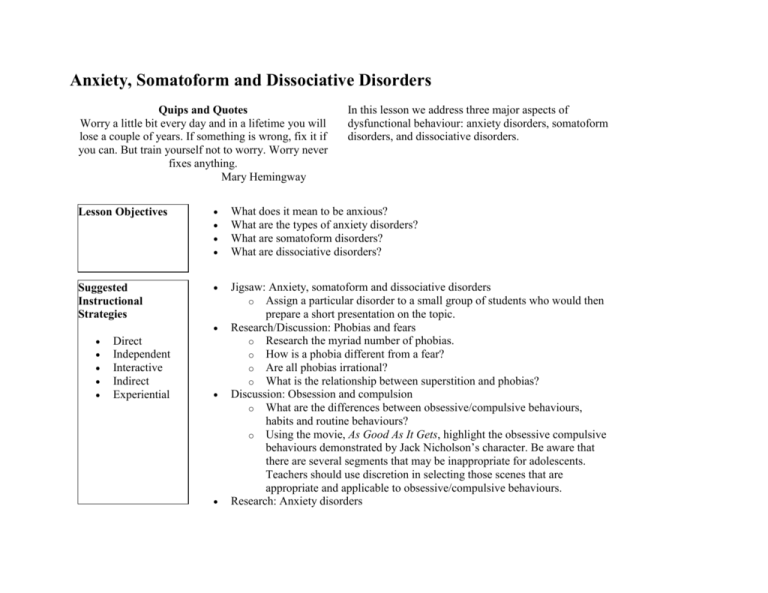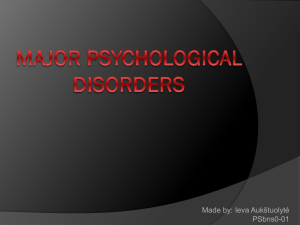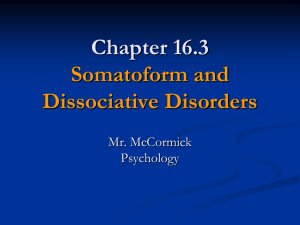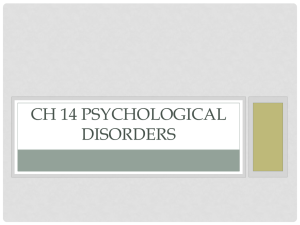Anxiety, Somatoform and Dissociative Disorders
advertisement

Anxiety, Somatoform and Dissociative Disorders Quips and Quotes Worry a little bit every day and in a lifetime you will lose a couple of years. If something is wrong, fix it if you can. But train yourself not to worry. Worry never fixes anything. Mary Hemingway In this lesson we address three major aspects of dysfunctional behaviour: anxiety disorders, somatoform disorders, and dissociative disorders. Lesson Objectives What does it mean to be anxious? What are the types of anxiety disorders? What are somatoform disorders? What are dissociative disorders? Suggested Instructional Strategies Jigsaw: Anxiety, somatoform and dissociative disorders o Assign a particular disorder to a small group of students who would then prepare a short presentation on the topic. Research/Discussion: Phobias and fears o Research the myriad number of phobias. o How is a phobia different from a fear? o Are all phobias irrational? o What is the relationship between superstition and phobias? Discussion: Obsession and compulsion o What are the differences between obsessive/compulsive behaviours, habits and routine behaviours? o Using the movie, As Good As It Gets, highlight the obsessive compulsive behaviours demonstrated by Jack Nicholson’s character. Be aware that there are several segments that may be inappropriate for adolescents. Teachers should use discretion in selecting those scenes that are appropriate and applicable to obsessive/compulsive behaviours. Research: Anxiety disorders Direct Independent Interactive Indirect Experiential o Design and conduct an investigation into the following: Anxiety: What situations cause students to be extremely anxious? Phobias: What are they afraid of? o Are there gender differences in the research results? o Are there age differences in the research results? Jigsaw: Theoretical perspectives on anxiety, somatoform and dissociative disorders o Assign one of the six theoretical perspectives to each small group of students. Based on their theoretical perspective, how would the groups explain anxiety, somatoform and dissociative disorders? What treatments and therapies would they recommend based on their interpretation of the causes of, or reasons for, anxiety, somatoform and dissociative disorders? Making Connections Refer to Topic 2.6, Personality for additional information. Refer to Topic 3.4, Self-understanding for additional information. Refer to Topic 4.6.1, Mood Disorders for additional information. Resources Movie: As Good As It Gets Lesson 4.6.2: Teacher Information What does it mean to be anxious? Anxiety is customarily considered a generalized feeling of fear and apprehension that may be related to a particular event or object and is often accompanied by increased physiological arousal. Anxiety is a key symptom of maladjustmentnot necessarily the cause of maladjustment (Lefton et al., 2000, p. 496). What are the types of anxiety disorders? The person with a panic disorder is afflicted by frequent and over-whelming attacks of anxiety. The anxiety at first is not really connected to anything specific; it is a physical occurrence. Soon, however, the panic begins to become associated with more and more objects, events and people. Phobic disorders involve an unreasonable, excessive and irrational fear of, and consequent attempt to avoid, specific objects or situations. Mild phobic disorders occur in about 7.5 percent of the population. They are, in fact, relatively common in welladjusted people. Severe, disabling phobias occur in less than 0.05 percent of the population, typically in patients with other disorders. Phobias occur most frequently between the ages of 30 and 60 and occur about equally in men and women. An obsession refers to an endless preoccupation with some type of urge or thought. A compulsion is a symbolic, ritualized behaviour that a person must act out repeatedly. The two words, obsessive-compulsive are generally used together. Most compulsive people are obsessed with their compulsion (McMahon and Romano, 1998, p. 512). An obsessive-compulsive disorder is an anxiety disorder characterized by persistent and uncontrollable thoughts and irrational beliefs (obsessions) that cause performance of intrusive and inappropriate compulsive rituals that interfere with daily life. The unwanted thoughts, urges and actions of people with obsessive-compulsive disorders focus on maintaining order and control. About two percent of the population suffer from obsessive-compulsive disorders. Of those with the disorder, about 20 percent have only obsessions or compulsions; about 80 percent have both. The term post-traumatic stress disorder is used to describe an anxiety disorder occurring in response to an extreme psychological or physical trauma outside the range of normal human experience. As well as war, such traumas include a physical threat to one's self or family, witnessing other people's deaths, and being involved in a natural or human-made disaster. PTSD may occur immediately following a traumatic experience or weeks, months and even years later. As well as tiredness, apathy, depression, social withdrawal and nightmares, veterans from the Vietnam war reported flashbacks of events they had witnessed or participated in. Victims of PTSD also report higher use of alcohol, drugs or violence to try to curb the disturbing symptoms (Gross and McIlveen, 1998, p. 604-611). What are somatoform disorders? In somatoform disorders, psychological issues are expressed in bodily symptoms, but there is no actual problem. There are two major types: o Conversion disorder, or “hysterical paralysis”, reflects a serious psychological trauma that is unconsciously transformed into a symbolic physical dysfunction. o Hypochondriacs see disastrous in a minor physical complaint (McMahon and Romano, 1998, p. 517). What are dissociative disorders? Dissociative disorders are characterized by a sudden but temporary alteration in consciousness, identity, sensory/motor behaviour or memory. Although relatively rare, these disorders are quite noticeable and sharply delineated: Dissociative amnesia is characterized by the sudden and extensive inability to recall important personal information, usually information of a traumatic or stressful nature. The condition, which is relatively rare, occurs most often during wars or natural disasters. Dissociative identity disorder, or multiple personality disorder, is characterized by the existence within an individual of two or more distinct personalities, each of which is dominant at particular times and directs the individual’s behaviour at those times. Each personality has unique traits and different memories and behavioural patterns. Each personality is often unaware of any other one, but when time passes cannot account for it. The switch from one personality to another usually is brought on by stress (Lefton et al., 2000, p. 537).









